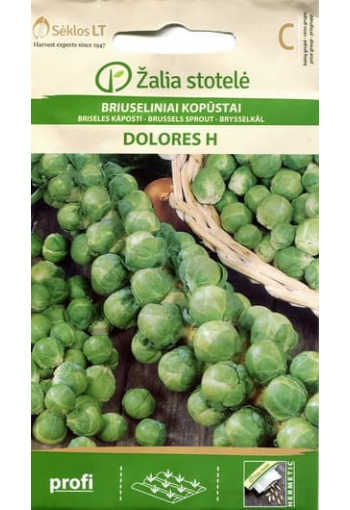Ex Tax: 1.14€
Early hybrid (120-130 days from planting to harvest), intended for fresh consumption and for processing. Plant height 100-110 cm.
On one plant, 20-35 heads are formed, the weight of one head is 6-10 g. Productivity is 0.5-0.8 kg/m2.
It is used fresh, as well as for canning and freezing. 1.0 g = 260-310 seeds.
Agrotechnics.
Brussels sprouts require more phosphorus and magnesium to improve the set and firmness of sprouts but require less nitrogen.
Sowing for seedlings is carried out in the second half of March. Seedlings are ready for planting 35-40 days after germination. Seedlings need to be hardened and fed.
Planting seedlings at the end of April according to the scheme 50 x 60 cm. Further care consists of watering, hilling, weeding and loosening.
During the growing season, 2 top dressings are carried out - the first 10 days after planting the seedlings, the second - 10 days after the first.
For the better formation of heads of cabbage, the top of the plants is removed 2-3 weeks before harvesting.
The crop is harvested selectively, cutting heads of cabbage as needed.
Eng.: Brussels Sprouts. Bot.: Brassica oleracea L. convar. oleracea var. gemmifera DC.
* Agricultural techniques for growing Brussels sprouts.
Brussels sprouts are one of the most valuable types of cabbage in terms of vitamins, protein, dry matter, potassium salts, magnesium, and phosphorus. In terms of amino acid content, its protein is not inferior to the protein of meat and milk. Brussels sprouts have the same amount of vitamin C as black currants. Moreover, the content of this vitamin in the heads of cabbage does not change both during storage and during processing.
Brussels sprouts are a biennial plant. There are no difficulties in growing it; the cultivation methods are the same as for mid-late varieties of white cabbage.
Brussels sprouts seeds are sown for seedlings from mid-March, but no later than April 20. Normal seedlings with 5-6 leaves are planted in the second or third decade of May, according to the 50x60 or 70x70 cm pattern.
An adult plant has a high stem (up to 70-80 cm) and in the axils of the leaves it forms from 20 to 60 heads. With dense plantings and shading, the yield is sharply reduced.
This type of cabbage is demanding soil fertility and moisture, is cold-resistant, and tolerates short-term cold snaps of up to +8+10°C during the head formation phase. Further care consists of watering, hilling, weeding and loosening. During the growing season, 2 feedings are carried out - the first 10 days after planting the seedlings and the second 10 days after the first. Complex mineral fertilizer is used for feeding.
To stimulate growth and formation of heads of cabbage, at the end of August, the top of the plant is pinched.
Harvesting begins in October and continues until late autumn. The harvest is harvested when the heads of cabbage become closed and dense. You can cut off the stems at the base and leave the heads on the stem or bury plants with a root system in the cellar. In this way, the heads of cabbage on a stump are stored for up to 2 months.











